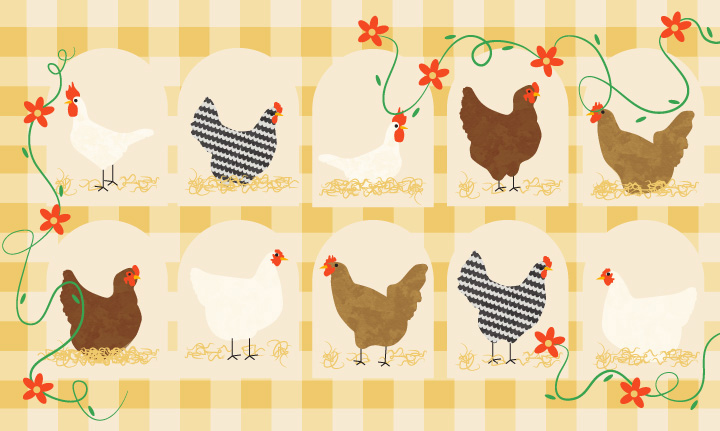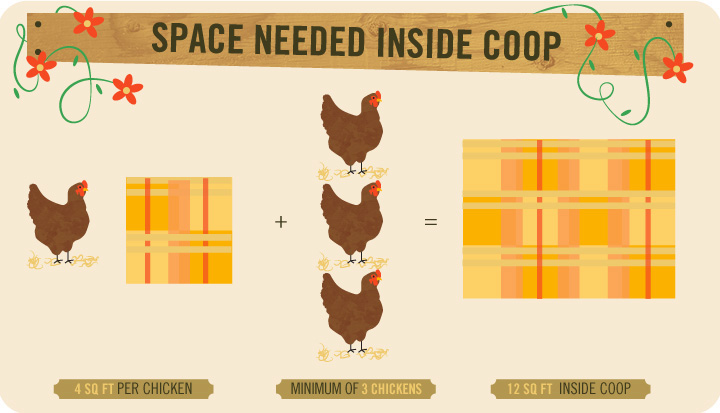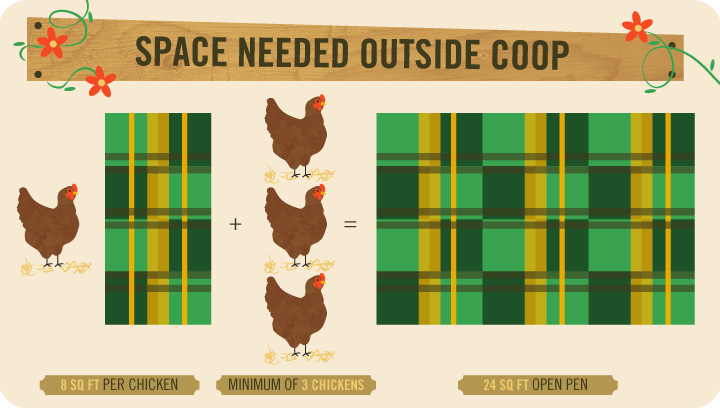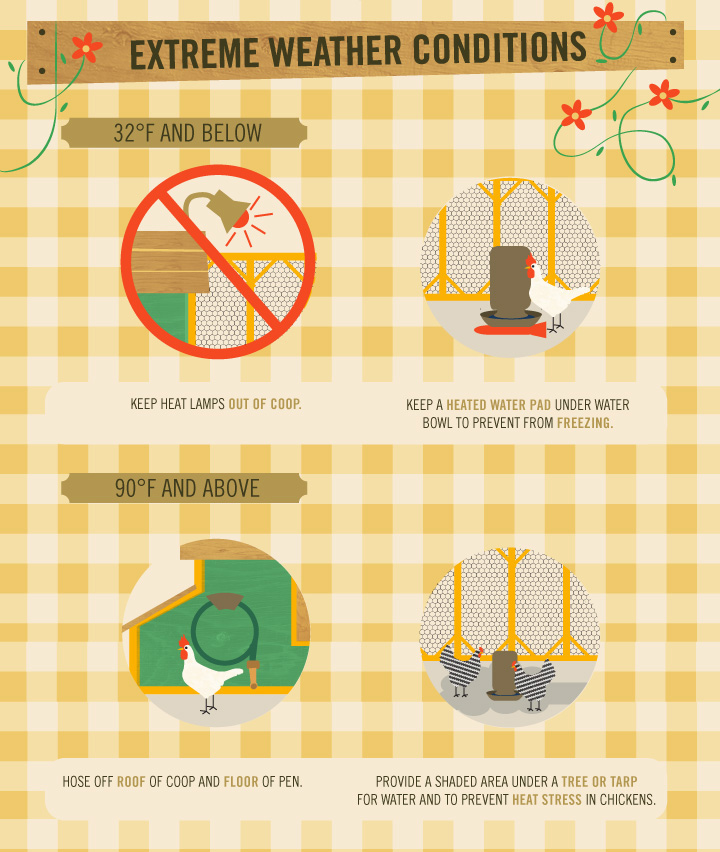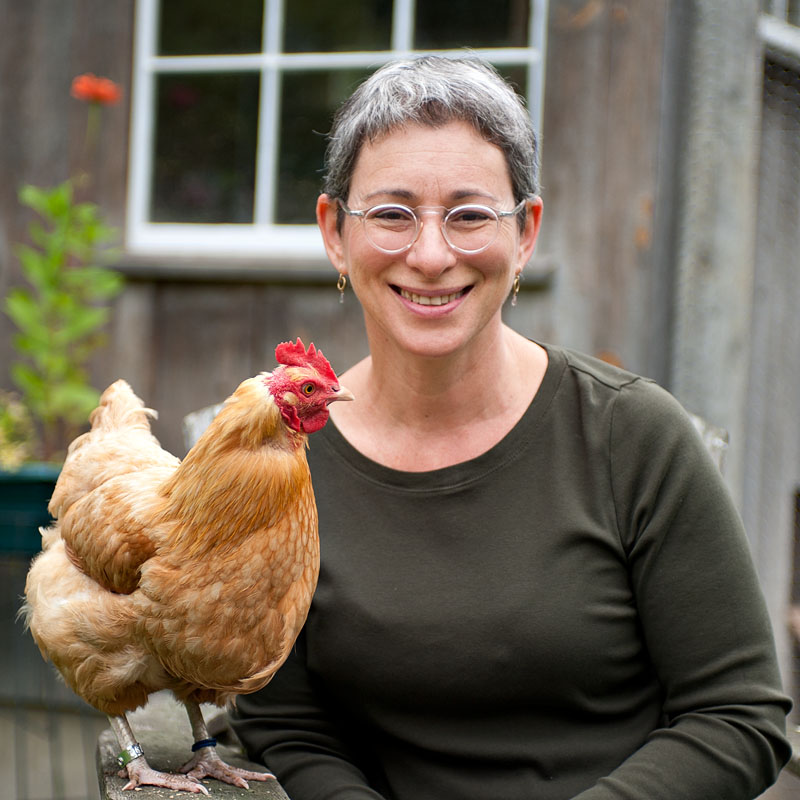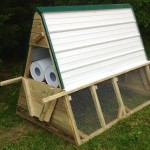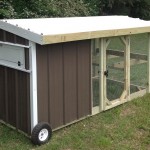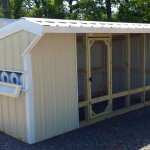How to Keep Chickens Healthy and Happy in An Urban Backyard
Increasingly, urban dwellers are choosing to raise chickens and embrace their inner farmer. There’s good reason for this — hens are the smallest of the domestic farm animals and the easiest to keep in a backyard. They are friendly birds that lay eggs and contribute nutrients to the compost pile. That said, chickens only thrive if they are provided with the right environment and care.
Home Sweet Home: Setting Up the Coop
Your chickens should live in a coop, but before you set up shop, keep this in mind: Chickens need more space than you may think. Set aside four square feet of floor space per hen, minimum. Less than that and hens will have behavioral issues, such as feather picking and bullying. Even if you have a small backyard, it’s not a great idea to keep just one hen. Chickens are flock animals and need to be with others of their kind. Start with a minimum of three chicks. By the way, a rooster is not necessary for the hens to lay eggs or to get along with each other. It’s okay to keep it to just girls in that urban flock.
The coop should have height, too; a low box won’t cut it. Hens don’t sleep in nests, but on roosts. Since chickens have best friends, they like to cozy up next to each other (and stay away from the hens that they don’t like). At bedtime your chickens will jostle for a favorite spot next to their buddies. Ideally, the coop should accommodate several roosts at different heights. A wooden ladder, leaning against the wall — make sure to attach it so it doesn’t fall — makes an excellent roost. Plan on a minimum of six linear inches per hen. The lowest roost should be at least eighteen inches off of the floor of the coop. This is because chickens poop (a lot!) when they sleep. Chicken manure is 75 percent liquid, which evaporates and dampens the air in the coop. As the manure decomposes, it gives off ammonia fumes. You don’t want your flock breathing any of that in as they sleep, because too much exposure can lead to respiratory diseases. The further from the manure the girls are, the more healthy the environment.
Fresh and Clean: Maintaining the Coop
To improve air quality and control flies, cover the floor of the coop with absorbent bedding, like pine shavings, and remove manure before it piles up. A fine-tined pitchfork is a great tool to keep the manure skipped out. Set aside just five minutes each morning to pick out the waste. Once a week do a more thorough cleaning, and every few months, remove all bedding and start fresh. Even a small coop in a city yard requires tools, including that pitchfork, a muck bucket, and a scrub brush for the waterer. Plan on a storage space for tools, feed,and shavings, in or near the coop — it will make chicken keeping that much easier.
Fresh, dry air is essential for your flock’s well being. Good ventilation makes a huge difference in air quality. Install vents along the eaves, windows that open, and, if possible, a cupola that pulls air up and out through the roof. But ventilation is a slippery slop since hens should not be housed in a drafty structure. This is why the chicken door (often called a pop hole) is only slightly larger than the hens themselves. The door allows hens to go in and out, but keeps wind and driving rain at bay. Conversely, it’s not good for the flock’s health to have a closed-up coop, as the air will be dusty, damp, and harbor pathogens. Even in the winter, don’t be tempted to seal it up tight.
Windows have additional benefits beyond letting in fresh air. Sunlight is necessary for egg laying and to stave off disease. Chickens can’t see in the dark. If your coop looks like a windowless doghouse, your hens will stay put on their roosts, even if the sun is shining outside. They won’t eat enough to be able to make eggs. And if your hens are in the dark, they won’t lay them either. If they’re not up and about and exercising, chickens are prone to disease. Sunlight is also a natural disinfectant. So plan on a coop with windows and let that sun shine in.
Hens lay eggs inside of the coop in nesting boxes. These should be lower than the roosts (so that the hens won’t sleep in them) and about 16-inches square. Three boxes are plenty for a flock of up to a dozen hens — they’ll all try to crowd into one even if the others are empty.
Chickens need plenty of room to roam outside of the coop, too. Most urban chickens are confined to a fenced run (for predator protection and to keep them in place — hens do wander.) Eight square feet per chicken in the pen is the minimum allotment, but more is better. Hens spend most of their day scratching the ground and the dirt in the runs packs down into an impermeable base. Occasionally turn the soil over with a pitchfork and add coarse sand to improve drainage. Loose earth makes the hens happy because they take dust baths in it, which is a communal activity that the hens enjoy. Dry dirt under the feathers also helps reduce any external parasites that the hens might harbor.
Safe and Sound: Protecting the Coop
Unfortunately, there are many predators that want a chicken or egg dinner, including foxes, raccoons, opossums, and black snakes. Hawks and owls are hunters from above.Good fencing is a must — rats can gnaw through chicken wire. Urban flocks are best protected by wire hardware cloth. Extend it below the ground by eight inches to deter digging predators. Cover the run with more hardware cloth or hawk netting as well. Keep away burrowing animals by installing a gravel trench around the perimeter of the pen. To deter mice and other vermin, keep the sides of the coop clear of woodpiles, clutter, and other things rodents like to hide in.
No fencing is secure against nighttime predators (weasels can slip through a 2-inch gap!). Always close your hens inside the coop at night. If you can’t be home at dusk, purchase an automatic door. But don’t worry, the chickens happily put themselves to bed as soon as it gets dark, and will all be inside before the door closes behind them.
Healthy Hens: Feeding Your Flock
Beyond keeping your chickens safe, the next order of business is food and water. It is best to have dispensers inside the coop where the pellets will stay dry. If there’s no space inside your coop for a feeder and waterer, then hang them outside under shelter during the day and store the feed inside a galvanized can each night (so you don’t feed mice and other critters).
Hens need proper nutrition to produce eggs and regrow feathers during the molt. Start with a quality laying hen pellet, which should have the optimum protein content of 16 percent. Although chickens love scratch corn, it isn’t necessary. In fact, feeding too much corn can lower your flock’s protein consumption, which can lead to thin-shelled eggs and may cause liver disease. Feed your flock corn and other carbohydrates — such as bread and leftover pasta —sparingly. On the other end of the spectrum, too much protein (often given in the form of mealworm treats) can cause kidney disease. Healthy additions to a hen’s diet are vegetables and fruits, such as pumpkins, zucchini, and apples. But don’t chop them up — pecking at whole vegetables can keep your flock busy.
Chickens require two supplements to their diet: oyster shell for calcium (to build strong eggs) and granite grit (to aid in digestion.) Offer these items to your flock free choice. A source of clean, fresh water is of the utmost importance. Dispensers designed for poultry will keep the water flowing and clean.
The average six-pound hen will eat upwards of four ounces of feed and drink four ounces of water a day. She’ll also produce four ounces of manure daily and her egg weighs about two ounces. Keep her glossy and healthy with a balanced diet.
Coop Comfort: Managing Temperatures
Your hens will be stressed by extremes in the weather. Although you can’t control Mother Nature, you can house and care for your flock to minimize the negative effects of bad weather. Chickens are prone to respiratory diseases, so it’s essential to keep their housing dry. As mentioned earlier, ventilation inside the coop is key. It’s crucial to keep their pen dry, too. Standing around in muddy pens will leave your hens susceptible to illness, so do what you can to improve drainage and give them outside roosts to get out of the muck.
Most new chicken keepers worry about their hens staying warm during the winter. Actually, cold is rarely a problem. A chicken has about 9,000 feathers, which keep her plenty toasty. Don’t use a heater, which is unnecessary and is always a fire hazard (chickens create a lot of dust and the air in the coop is highly flammable.) Hens do need to stay out of strong winds and they appreciate it if you shovel snow out of their pen. The most important winter chore is to keep the waterer from freezing. Even a couple of hours without fresh flowing water can cause health issues. A heated metal pad designed for use under waterers is available at most feed stores.
Do worry when the temperature soars. Chickens are prone to heat stress and will die in extreme hot weather if there’s nowhere to escape the sun. Put up a shade tarp if necessary. Chickens won’t drink warm water, so provide cool water in a shady spot. When temperatures near triple digits, cool things off by hosing the roof of the coop and the dirt in the pen. Some coops can benefit from a fan to move the air.
Chickens are curious, active animals that get bored and will develop bad habits (like eating feathers off of each other) if kept in an improper environment. However, they’re easily entertained and there are plenty of ways to enrich their lives. If their enclosure doesn’t have loose, dry dirt to dust bathe in, put a kitty litter tub filled with sand into the pen. Provide outside roosts or a stepladder and stumps for the hens to stand and roost on. Give them a hard winter squash that requires hours of pecking to eat. Hang a wild bird suet feeder in the coop and fill it with kale and other greens. Also, spend time with your hens — they really do like human company.
If this article has you considering a coop addition to your home, take a look at this rolling chicken coop — http://www.custommade.com/4×8-rolling-chicken-coop/by/rockytopsales/
